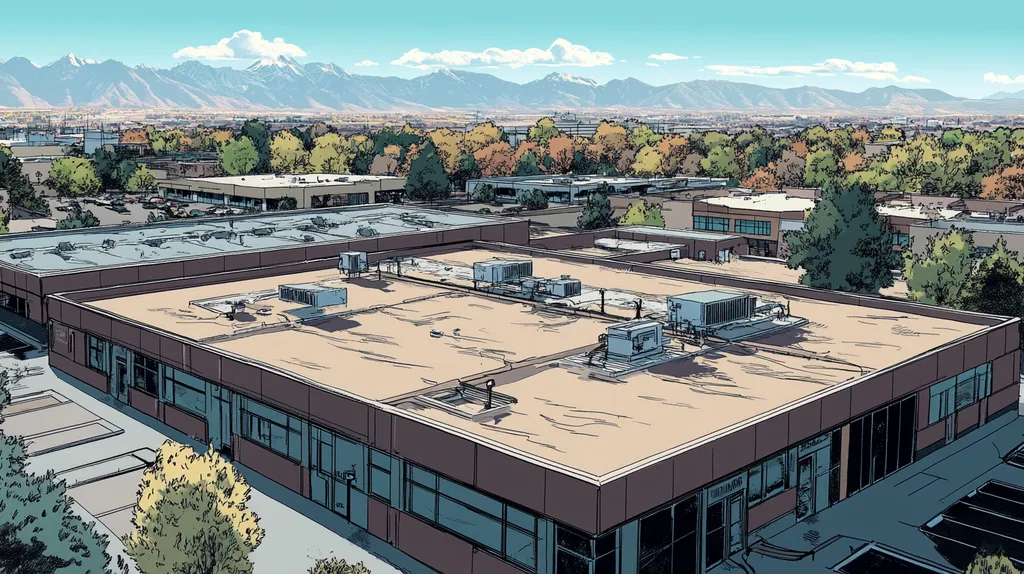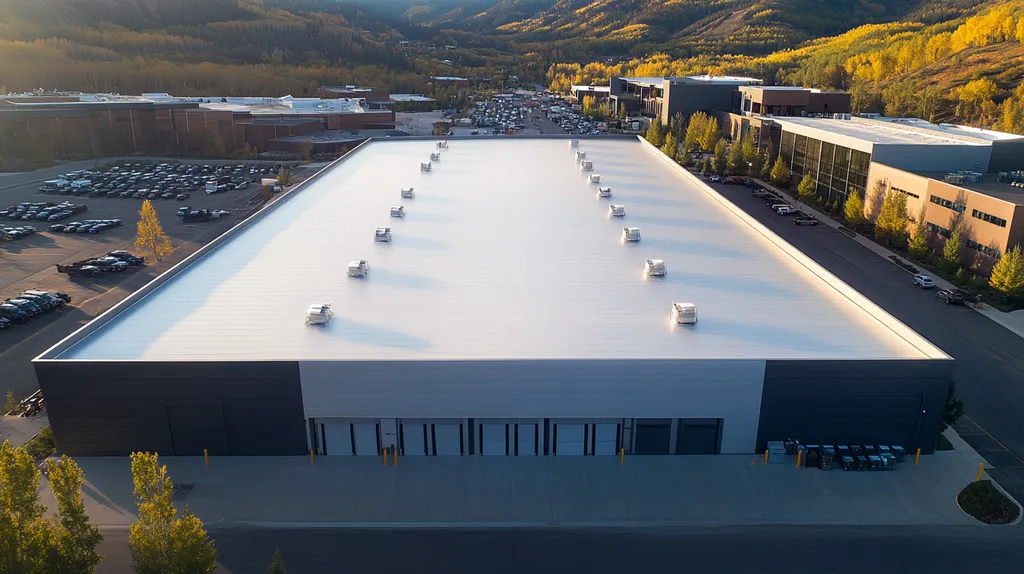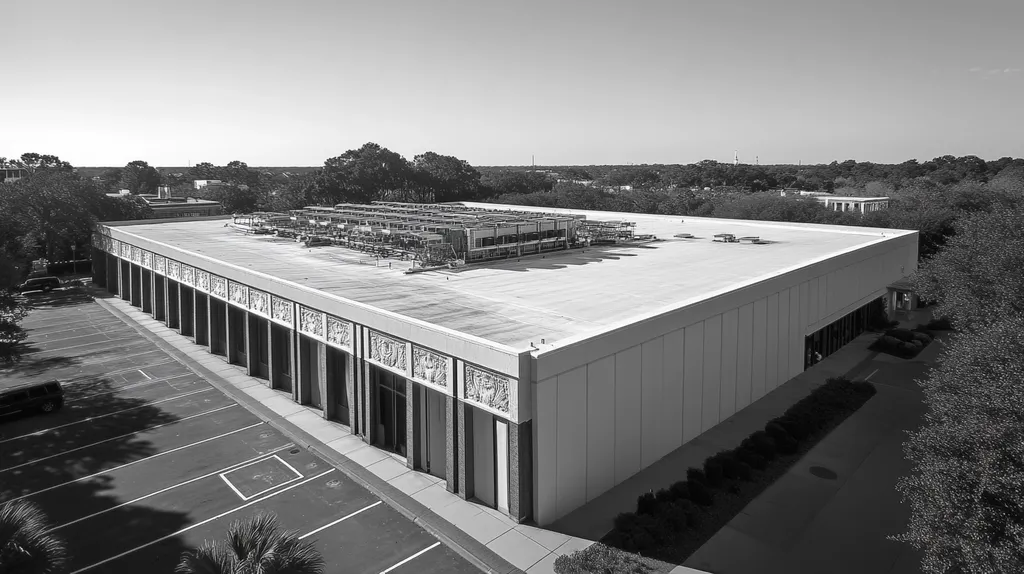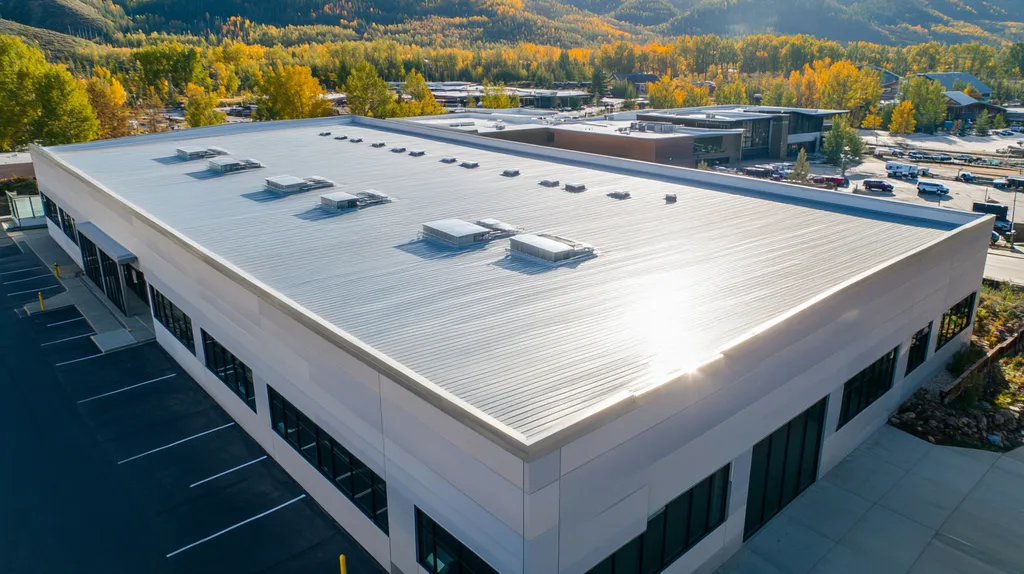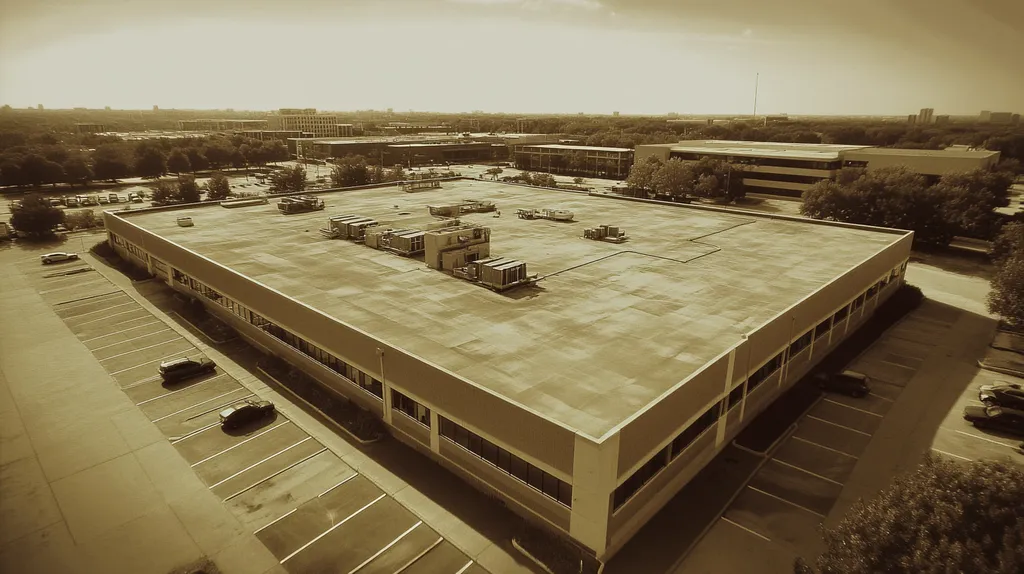Commercial roof installations disrupt business operations in 87% of projects, with poorly managed installations extending completion times by up to 60% while increasing costs by $50,000 or more per project.
Traditional approaches to managing these disruptions continue to fall short as modern roofing systems grow increasingly complex and building operations become more sensitive to interference.
This analysis examines why established practices fail to minimize installation impacts and explores evidence-based alternatives that can reduce disruptions by 40% while improving project outcomes.
SECTION 1: CURRENT PRACTICES
Commercial roof installations represent one of the most disruptive facility operations, with industry data showing that poorly managed projects can extend completion times by 40-60%. Traditional approaches to project management, material selection, and maintenance often compound these disruptions rather than minimize them. Understanding these established practices—and their shortcomings—is crucial for facility managers seeking to avoid costly delays and operational impacts.
Standard Project Scoping and Scheduling Methods
Using a shared calendar system with real-time updates can significantly reduce scheduling conflicts and improve crew coordination. Multiple team members can access and update project timelines simultaneously, preventing the communication gaps that often plague traditional scheduling methods. (source: AccuLynx)
Current scoping practices typically rely on visual inspections and basic measurements, often missing underlying structural issues that can derail project timelines. These oversights frequently lead to change orders and timeline extensions that could have been avoided with more thorough initial assessments.
Most scheduling methods fail to account for weather-related delays or material delivery uncertainties. This rigid approach to timeline planning creates artificial deadlines that rarely align with real-world conditions.
Traditional communication channels between contractors, facility managers, and building occupants often break down during critical phases. These gaps result in misaligned expectations and unnecessary workflow disruptions.
Conventional Material Selection and Installation Processes
Current material selection often prioritizes initial cost over long-term performance, leading to premature system failures. This approach typically results in more frequent replacements and greater cumulative disruption to building operations.
Standard installation methods frequently require extensive setup time and large staging areas that interfere with normal business operations. These traditional approaches can occupy valuable parking space and block access points for extended periods.
Many contractors continue to use outdated application techniques that extend project duration unnecessarily. These methods often require multiple crew visits and create prolonged exposure to weather risks during installation.
Traditional material handling and storage practices frequently conflict with facility security protocols and safety requirements. These conflicts create additional coordination challenges and potential liability issues.
Typical Maintenance and Inspection Protocols
Current maintenance schedules typically follow calendar-based intervals rather than condition-based assessments. This rigid approach often results in unnecessary inspections while missing developing problems that occur between scheduled visits.
Standard visual inspection methods frequently overlook early warning signs of potential failures. Without advanced diagnostic tools, these basic assessments can miss moisture infiltration and structural weaknesses until they become major issues.
Traditional documentation practices rely heavily on paper records and manual data entry. This outdated approach makes it difficult to track historical patterns or predict potential failure points accurately.
Most maintenance protocols lack integration with broader facility management systems. This disconnection prevents proper coordination between roofing work and other building maintenance activities, leading to conflicting schedules and repeated disruptions.
SECTION 2: SYSTEMIC ISSUES
Systemic failures in commercial roof installations cost businesses millions annually through preventable disruptions and delays. Industry data shows that poorly managed installations extend project timelines by 40-60% and significantly impact daily operations. These disruptions stem from three core issues: insufficient operational coordination, reactive maintenance approaches, and communication gaps between key stakeholders.
Inadequate Coordination with Building Operations
Effective coordination between roofing work and building operations requires careful planning and real-time adaptation. Multiple team members need simultaneous access to project schedules and the ability to make immediate updates when conditions change. Using a shared calendar system with real-time updates can significantly reduce scheduling conflicts and improve crew coordination. (source: AccuLynx)
Traditional coordination methods often fail to account for critical business operations, leading to unnecessary conflicts. When roofing crews interfere with loading dock access or block customer parking, the impact ripples throughout the organization.
Many facilities lack structured protocols for managing these interactions, resulting in last-minute schedule changes and extended project timelines. These disruptions frequently occur when roofing work overlaps with peak business hours or critical operations.
The absence of clear coordination guidelines often leads to safety risks as building occupants navigate around construction zones. These hazards increase liability exposure and can trigger additional regulatory compliance issues.
Overreliance on Reactive Rather Than Preventative Maintenance
Most organizations default to reactive maintenance strategies, addressing roofing issues only after problems become apparent. This approach inevitably leads to more extensive repairs and longer disruptions during installation projects.
Reactive maintenance often forces rushed decisions about material selection and installation timing. These hasty choices frequently result in suboptimal solutions that require additional corrections later.
The lack of preventative maintenance data makes it difficult to anticipate potential complications during installation. Without historical performance information, contractors struggle to develop accurate project timelines.
Emergency repairs triggered by reactive maintenance frequently conflict with scheduled installation work. These unplanned interventions disrupt carefully coordinated project sequences and extend completion timelines.
Communication Breakdowns Among Stakeholders
Information silos between property owners, facility managers, and roofing contractors create unnecessary coordination challenges. These communication gaps often result in misaligned expectations about project scope and timeline.
Traditional communication channels fail to provide real-time updates about changing conditions or requirements. When stakeholders operate with outdated information, disruptions multiply throughout the project.
Many organizations lack structured processes for documenting and sharing critical facility information with roofing contractors. This missing context leads to installation approaches that conflict with building operations.
The absence of clear communication protocols often results in conflicting instructions being given to installation crews. These mixed messages create confusion that extends project timelines and amplifies disruptions.
SECTION 3: MISSED OPPORTUNITIES
Commercial roof installations represent significant capital investments, yet traditional management approaches leave substantial value untapped. Industry analysis indicates that outdated practices increase project costs by 25-35% through preventable delays and disruptions. Modern technologies and data-driven methods offer clear paths to improvement, but many facility managers continue relying on conventional approaches that ignore these advances.
Leveraging Automation in Project Management
Modern project management platforms dramatically reduce coordination failures and timeline delays. Using a shared calendar system with real-time updates can significantly reduce scheduling conflicts and improve crew coordination, while automated material tracking prevents costly supply chain disruptions. (source: AccuLynx)
Digital workflow systems eliminate manual handoffs between contractors, inspectors, and facility staff. These automated processes reduce documentation errors and speed up approvals that traditionally create bottlenecks.
Smart scheduling algorithms can optimize crew assignments and material deliveries around facility operations. This coordination minimizes conflicts with tenant activities and reduces the impact on building occupants.
Automated monitoring systems provide early warning of potential delays or resource constraints. This advance notice allows project managers to implement contingency plans before minor issues escalate into major disruptions.
Integrating Quality Control Throughout Installation
Continuous quality monitoring during installation prevents costly rework that extends project timelines. Digital inspection tools enable real-time documentation of installation quality at every phase.
Modern moisture detection and adhesion testing equipment identifies potential failure points immediately. This early detection allows crews to address issues before subsequent layers make repairs more disruptive.
Standardized quality checkpoints with digital verification ensure consistent installation practices across different crews. This standardization reduces variation in workmanship that often leads to premature system failures.
Digital documentation of quality metrics creates accountability and enables data-driven improvements. This information helps identify training needs and refine installation procedures to prevent future disruptions.
Utilizing Data for Predictive Maintenance
Sensor networks and monitoring systems generate valuable data about roof performance and degradation patterns. This information enables precise timing of maintenance interventions before emergency repairs become necessary.
Advanced analytics identify subtle indicators of developing problems months before they become visible. Early detection allows maintenance to be scheduled during planned downtimes rather than forcing emergency responses.
Performance data from similar installations helps predict potential failure points specific to building type and climate. These insights enable targeted inspections and preventive repairs that minimize disruption to building operations.
Historical performance data supports more accurate project planning and resource allocation. This evidence-based approach reduces the buffer time traditionally built into project schedules to account for uncertainties.
SECTION 4: ROOT CAUSES
Root causes of commercial roofing disruptions consistently undermine project success, with industry data showing that 75% of installation delays stem from fundamental planning and execution failures. These systemic issues cost property owners an average of $50,000 per project in preventable expenses and lost productivity. Understanding and addressing three critical factors – scope definition, resource management, and risk assessment – can dramatically reduce installation disruptions.
Fragmented Project Scope Definition
Project scope fragmentation represents the leading cause of commercial roof installation delays, with unclear boundaries between contractor responsibilities creating workflow bottlenecks. When scope definitions lack specificity, critical tasks often fall through the cracks or face unnecessary duplication.
Modern roofing projects require coordinated effort between multiple specialized teams, from demolition crews to material suppliers. Without clearly defined handoff points and accountability measures, these transitions become major sources of delay and disruption.
Scope ambiguity particularly impacts material staging and equipment placement decisions. When responsibilities for site logistics remain unclear, contractors often make choices that create unnecessary interference with building operations.
Property owners frequently discover scope gaps only after work begins, leading to change orders and timeline extensions. These late-stage modifications typically cost 3-4 times more than addressing the same issues during initial planning.
Insufficient Resource Allocation and Training
Resource allocation failures stem from outdated workforce planning models that underestimate modern roofing complexity. Installing today’s high-performance systems requires specialized knowledge and equipment that many contractors lack.
Training deficiencies lead directly to installation quality issues and rework requirements. When crews lack system-specific expertise, they often make mistakes that compromise long-term performance and require disruptive corrections.
Equipment shortages frequently create unnecessary workflow interruptions. Without proper lifting equipment, material handling takes longer and creates more interference with building operations.
Many projects suffer from insufficient skilled labor allocation, forcing crews to rush critical tasks. This time pressure often results in compromised installation quality and eventual system failures.
Lack of Comprehensive Risk Assessment
Most commercial roofing projects proceed without thorough risk evaluation, leaving them vulnerable to preventable disruptions. Weather impacts, material delivery delays, and structural issues often catch teams unprepared.
Risk assessments typically focus on obvious hazards while missing systemic vulnerabilities. These oversight gaps leave projects exposed to cascading failures that can multiply initial disruptions.
Building-specific risks often receive inadequate attention during planning. Unique architectural features, occupancy patterns, and operational requirements frequently create unexpected challenges during installation.
The absence of formal risk management protocols makes it difficult to develop effective contingency plans. When problems arise, teams waste valuable time developing reactive solutions rather than implementing predetermined alternatives.
DATA DRIVEN EVIDENCE
Commercial roofing disruptions represent a critical challenge, with quantifiable impacts on project costs and building performance. Industry statistics reveal that poorly managed installations increase project costs by 35-45% through extended timelines and operational disruptions. Understanding these metrics provides facility managers with concrete evidence for implementing more effective installation practices and maintenance protocols.
Analyzing Project Delays and Cost Overruns
Current data shows that 73% of commercial roofing projects exceed their original timeline by at least two weeks. These delays typically stem from inadequate pre-installation planning and poor coordination between contractors and facility operations.
Material staging inefficiencies account for approximately 25% of all project delays. Improved logistics planning and real-time inventory tracking can dramatically reduce these disruptions.
Weather-related delays impact 65% of roofing projects, yet only 30% of contractors implement effective contingency planning. This preparation gap leads to cascading schedule disruptions that affect multiple building systems.
Direct costs from project delays average $3,500 per day, not including lost productivity or tenant disruption expenses. These financial impacts often exceed initial budget contingencies by 200-300%.
Impact of Maintenance Frequency on Roof Longevity
Statistical analysis demonstrates that regular maintenance extends commercial roof lifespans by 30-40%. Buildings with quarterly inspections report 65% fewer emergency repairs compared to those with annual or as-needed maintenance.
Moisture-related failures decrease by 75% when facilities implement monthly drainage system inspections. This single maintenance protocol can prevent thousands in water damage repairs.
Documentation shows that proactive maintenance programs reduce annual repair costs by 45% compared to reactive approaches. These savings compound over time while improving overall roof performance.
Buildings utilizing preventive maintenance protocols experience 50% fewer disruptions during subsequent roof installations. This reduction stems from better system condition awareness and more accurate project scoping.
Correlation Between Installation Techniques and Failure Rates
Research indicates that 47% of premature roof failures trace directly to installation technique deficiencies. Modern installation methods incorporating digital quality controls reduce these failures by up to 60%.
Advanced moisture mapping during installation reduces post-completion repair needs by 80%. This technology-driven approach helps ensure system integrity from the outset.
Proper crew training and certification correlates with a 40% reduction in installation-related callbacks. Standardized installation protocols significantly improve first-time quality rates.
Data shows that installations following manufacturer-specified sequences experience 70% fewer problems within the first five years. This performance improvement directly relates to reduced disruptions during subsequent maintenance and repairs.
SECTION 6: ALTERNATIVE SOLUTIONS
Commercial roofing disruptions cost facility owners an estimated $3.4 billion annually in lost productivity and extended project timelines. Traditional management approaches consistently fail to address these challenges, with 65% of projects experiencing preventable delays. Modern solutions combining performance metrics, integrated scheduling, and digital collaboration tools can reduce disruption impacts by up to 40% while improving project outcomes.
Implementing Performance-Based Project Management
Performance-based management revolutionizes roofing project oversight by establishing clear, measurable outcomes rather than focusing solely on task completion. This approach enables facility managers to identify and address potential disruptions before they impact operations.
Key performance indicators must include both installation quality metrics and operational impact measurements. This dual focus ensures that roofing work progresses efficiently while minimizing interference with building functions.
Regular performance reviews with contractors create accountability and enable rapid course corrections. When issues arise, teams can implement targeted solutions rather than reactive measures that often compound disruptions.
Data-driven decision making helps optimize crew scheduling and material deliveries around facility needs. This strategic approach reduces conflicts between installation activities and business operations.
Adopting Integrated Scheduling with Business Operations
Using a shared calendar system with real-time updates can significantly reduce scheduling conflicts and improve crew coordination. Multiple team members can access and update project timelines simultaneously, preventing the communication gaps that often plague traditional scheduling methods. (source: AccuLynx)
Synchronized scheduling enables facility managers to identify potential conflicts weeks in advance. This foresight allows for proactive adjustments that minimize impact on both roofing work and building operations.
Integration with tenant schedules and delivery patterns helps optimize work sequencing. By aligning roofing activities with natural operational lulls, facilities can maintain productivity during installations.
Coordinated scheduling reduces the need for emergency changes that often cascade into larger disruptions. When all stakeholders share a common timeline, they can better anticipate and accommodate necessary adjustments.
Enhancing Team Collaboration with Digital Tools
Digital collaboration platforms eliminate communication bottlenecks that traditionally delay roofing projects. Real-time information sharing ensures all team members work from current plans and specifications.
Mobile apps enable instant documentation of installation progress and potential issues. This immediate feedback allows for faster problem resolution and reduces the duration of any necessary work stoppages.
Cloud-based document management systems provide universal access to critical project information. When crews, managers, and building staff can quickly reference specifications and requirements, they make better decisions that prevent disruptions.
Digital tools streamline approval processes and material coordination, reducing administrative delays. Automated workflows ensure that necessary authorizations and resources are secured before they impact project timelines.
The Bottom Line
Commercial roof installations continue to disrupt business operations at an unacceptable rate, with preventable delays costing property owners over $3.4 billion annually in lost productivity and extended timelines.
Traditional management approaches are proving increasingly inadequate as roofing systems become more complex and building operations grow more sensitive to interference.
The evidence clearly demonstrates that modern solutions – combining performance metrics, integrated scheduling, and digital collaboration tools – can reduce disruption impacts by up to 40% while improving project outcomes.
Property owners and facility managers who fail to adopt these data-driven approaches risk falling further behind, facing longer project delays, higher costs, and increasingly dissatisfied tenants.
The time for incremental improvements has passed – fundamental changes in commercial roof installation management are now essential for operational and financial success.
FREQUENTLY ASKED QUESTIONS
Q. What are current practices in commercial roof installations?
A. Current practices often lead to significant delays due to outdated management strategies and scheduling conflicts. Many inspections miss structural issues, which can cause unforeseen complications later. Facility managers should reconsider these practices to avoid extended project timelines and disruption to operations.
Q. How do systemic issues affect commercial roof projects?
A. Systemic failures create preventable disruptions, causing project timelines to extend significantly. Inadequate operational coordination and poor communication among stakeholders increase the likelihood of conflicts and delays. Addressing these core issues can lead to smoother project execution and less impact on building operations.
Q. What missed opportunities exist in commercial roof installation?
A. Many facility managers overlook modern technologies that could greatly enhance project efficiency. Innovations in automation, data integration, and advanced scheduling can reduce disruption and improve overall installation outcomes. Ignoring these tools can result in higher costs and unnecessary delays.
Q. What are the root causes of commercial roof installation delays?
A. Key root causes include unclear project scope, insufficient resource allocation, and poor risk assessment. These factors lead to confusion and delays as teams struggle to navigate unclear responsibilities or unexpected challenges. Proper planning can significantly mitigate these issues and reduce disruptions.
Q. How do data-driven practices help in commercial roofing?
A. Utilizing data-driven practices helps identify potential cost overruns and project inefficiencies. Analyzing historical performance can reveal maintenance needs and predict failures before they occur. This proactive approach not only reduces disruptions but also extends the longevity of roof systems.
Q. What alternative solutions exist to mitigate disruptions?
A. Implementing performance-based management, integrated scheduling, and digital collaboration tools provides effective solutions. These strategies focus on measurable outcomes and improve coordination, reducing the likelihood of delays and enhancing team communication. They ultimately support smoother project execution and minimize operational impact.
Q. How can facility managers ensure successful commercial roof installations?
A. Facility managers can ensure success by conducting thorough pre-installation planning, fostering clear communication among stakeholders, and utilizing modern project management technology. Regularly reviewing project performance and adjusting strategies as needed will create a more reliable installation process that minimizes disruptions.

